Lower
Belvedere, Vienna:
23.03 – 26.08.2018
BOZAR – Centre for Fine Arts, Brussels:
21.09.2018 – 20.01.2019
Exactly one hundred years on from their deaths, the
Austrian artists Gustav Klimt and Egon Schiele are still big names on the international
art scene. The exhibition Beyond Klimt doesn’t just present the late work of
these great masters, it gives visitors the
chance to familiarise themselves with the international avant- garde
movements - surrealism, expressionism, new realism, constructivism, Bauhaus etc. - which
flourished after WWI in the young national states emerging from the gone
Austro-Hungarian Empire.
The exhibition features approximately eighty artists,
including Gustav Klimt, Oskar Kokoschka, Koloman Moser, Egon Schiele, László
Mohaly-Nagy, František Kupka and Alfred Kubin.
The First World War caused a
rift in European (art) history, resulting in radical geopolitical, economic and
artistic changes. In 1918 the Austro-Hungarian Empire was permanently divided
up into smaller nation states*. 1918 is also the year in which the renowned
artists Gustav Klimt, Egon Schiele, Koloman Moser and Otto Wagner died. As
figureheads of the ‘Wiener Sezession’, their characteristic Art Nouveau style
embodied the heyday of the Viennese Belle Epoque. Their death represented the
end of an era. But what came after them? How have they influenced the next
generation of artists and which artistic trends flourished in this region?
Beyond Klimt portrays the artistic
developments and diverse avant- garde movements in Central Europe between the
key years of 1914 and 1938**. Artists
from the former Austro-Hungarian Empire made contacts with art scenes throughout
the world: they formed networks, used magazines to communicate across the new
political borders and met up in art centres and associations. They believed
their artistic identity was more important than their nationality. The
intensive exchange of ideas resulted in international movements such as
surrealism, expressionism, neorealism and constructivism. This internationalism
came to an abrupt end with the outbreak of the Second World War, when the
feeling of a shared culture was pushed to the background.
An exhibition by the
Belvedere, Vienna and the Centre for Fine Arts, Brussels (BOZAR) in collaboration
with the Museum of Fine Arts – Hungarian National Gallery, Budapest. The
exhibition will be shown at the Centre for Fine Arts, Brussels (BOZAR) to
coincide with the Austrian Presidency of the Council of the European Union. It
is a contribution to the European Year of Cultural Heritage 2018.
From art nouveau to expressionism
Before the start of the
First World War, seismic changes were taking place all over Europe that
affected all parts of society. These changes proved to be a catalyst for modern
art. Artists from the ‘father generation’, such as Alfons Mucha, József
Rippl-Rónai, and Gustav Klimt, paved the way to modernism. As prominent
representatives of separate secessionist movements, they had already gained
cult status in the former crown lands of the Austro-Hungarian Empire. The
sweeping changes brought by the war forced the artists to adopt a new approach.
Gustav Klimt and his Czech colleagues Alfons Mucha and Jan Preisler focused primarily on decorative allegory. The Hungarian painter József Rippl-Rónai adopted a Post-Impressionist signature style. The younger generation is juxtaposed with the older masters in this exhibition. Artists such as Max Oppenheimer, Egon Schiele, Oskar Kokoschka, József Nemes-Lampérth, and Lajos Tihanyi, who developed their own distinctive approach to Expressionism, are shown in a sort of dialogue.
Form art and the Fantastic
While Art Nouveau in Vienna was inspired by geometric and ornamental forms, as can be seen in the work of Gustav Klimt and Adolf Hölzel, at a slightly later date in Prague Czech Cubism was being developed by artists such as Antonín Procházka and Bohumil Kubišta, and also František Kupka, who was painting non-representational works.
What both movements have in common is their connection to Form Art, which was significantly influenced by the pedagogical principles of Johann Friedrich Herbart. Based on the reduction of every object to the most basic geometric shapes (of geometric trigonometry), his philosophy and teachings led the way for the entire Austrian-Hungarian Empire starting in the mid- nineteenth century.
Such constructivist methods of composition were accompanied by a tendency in the opposite direction: ambivalent content that oscillated between meditation and alienation, linking narrative and fantastical elements of older artists such as Alfred Kubin, Richard Teschner, and Ivan Meštrović, with the younger artists such as Jan Zrzavý. Meštrović and Zrzavý provided glimpses into the internal world of the human soul.
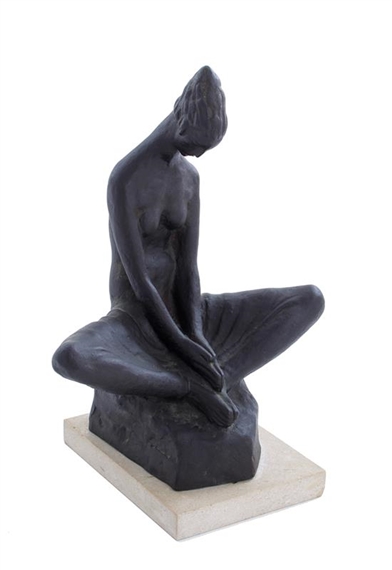

Meštrović’s Vestal Virgin sits in a contemplative pose, and Zrzavý’s fantastical figures exude a captivating radiance. Their sense of internal peace is an expression of humanity that represents a complete contrast to the diabolical aspects of war depicted in Kubin’s gruesome visions, which are presented in other halls of the exhibition.
War and Disillusionment
The initial enthusiasm for the war felt by most artists quickly evaporated. Many artists, even older ones such as László Mednyánsky and Albin Egger-Lienz, sought work as correspondents in the War Press Office. They compassionately documented the events of the war. János Vaszary’s Soldiers in the Snow, for example, shows exhausted figures in ragged clothing, whose visible suffering starkly contrasts with the mobilising and propagandistic effect of Alois Schramm’s Guard of the Carpathians. Human suffering is the subject of the stylised, symbolic pictures of Albin Egger-Lienz and Robert Angerhofer as well as Jan Štursa’s sculpture Wounded Man.
Georg Trakl’s last poem Gródek describes the beginning of the Carpathian Winter War that drove him to suicide. The campaign claimed so many lives in 1914–15 that it is comparable to the losses at Verdun. While in Western Europe Verdun is today considered a symbol of the inhumanity of war, in the Austro-Hungarian Empire this role is taken by the fortress Przemyśl, which also found its way into the work of Alfred Kubin. Klemens Brosch was marked by his participation in this campaign for the rest of his life. His trauma is reflected in drawings that capture the mercilessness and the horrors that had been previously inconceivable.
Gustav Klimt and his Czech colleagues Alfons Mucha and Jan Preisler focused primarily on decorative allegory. The Hungarian painter József Rippl-Rónai adopted a Post-Impressionist signature style. The younger generation is juxtaposed with the older masters in this exhibition. Artists such as Max Oppenheimer, Egon Schiele, Oskar Kokoschka, József Nemes-Lampérth, and Lajos Tihanyi, who developed their own distinctive approach to Expressionism, are shown in a sort of dialogue.
Form art and the Fantastic
While Art Nouveau in Vienna was inspired by geometric and ornamental forms, as can be seen in the work of Gustav Klimt and Adolf Hölzel, at a slightly later date in Prague Czech Cubism was being developed by artists such as Antonín Procházka and Bohumil Kubišta, and also František Kupka, who was painting non-representational works.
What both movements have in common is their connection to Form Art, which was significantly influenced by the pedagogical principles of Johann Friedrich Herbart. Based on the reduction of every object to the most basic geometric shapes (of geometric trigonometry), his philosophy and teachings led the way for the entire Austrian-Hungarian Empire starting in the mid- nineteenth century.
Such constructivist methods of composition were accompanied by a tendency in the opposite direction: ambivalent content that oscillated between meditation and alienation, linking narrative and fantastical elements of older artists such as Alfred Kubin, Richard Teschner, and Ivan Meštrović, with the younger artists such as Jan Zrzavý. Meštrović and Zrzavý provided glimpses into the internal world of the human soul.


Meštrović’s Vestal Virgin sits in a contemplative pose, and Zrzavý’s fantastical figures exude a captivating radiance. Their sense of internal peace is an expression of humanity that represents a complete contrast to the diabolical aspects of war depicted in Kubin’s gruesome visions, which are presented in other halls of the exhibition.
War and Disillusionment
The initial enthusiasm for the war felt by most artists quickly evaporated. Many artists, even older ones such as László Mednyánsky and Albin Egger-Lienz, sought work as correspondents in the War Press Office. They compassionately documented the events of the war. János Vaszary’s Soldiers in the Snow, for example, shows exhausted figures in ragged clothing, whose visible suffering starkly contrasts with the mobilising and propagandistic effect of Alois Schramm’s Guard of the Carpathians. Human suffering is the subject of the stylised, symbolic pictures of Albin Egger-Lienz and Robert Angerhofer as well as Jan Štursa’s sculpture Wounded Man.
Georg Trakl’s last poem Gródek describes the beginning of the Carpathian Winter War that drove him to suicide. The campaign claimed so many lives in 1914–15 that it is comparable to the losses at Verdun. While in Western Europe Verdun is today considered a symbol of the inhumanity of war, in the Austro-Hungarian Empire this role is taken by the fortress Przemyśl, which also found its way into the work of Alfred Kubin. Klemens Brosch was marked by his participation in this campaign for the rest of his life. His trauma is reflected in drawings that capture the mercilessness and the horrors that had been previously inconceivable.
Revolution
and Rebirth
Many avant-garde journals became active, dynamic platforms of art.
As well as offering social criticism on all aspects of public and cultural
life, they also facilitated artistic exchange in international networks. Some
of the most important journals were MA, Integral, Contimporanul, Egység, and Zenit. The production
of politically motivated art was also reflected in the posters of the era, such
as the one by Vojtěch Preissig, who during the war had called people to fight
for a future Czechoslovakian republic, or the famous poster by Mihály Bíró
making propaganda for the new Hungarian Republic of Councils in 1919. These
posters document the spirit of euphoria and revolution that was dominant in the
various artistic circles of the 1920s. While the political posters mostly
achieved their effect through emotionalising imagery, the opposite was true of
the new, rational method of popular education developed by the economist Otto
Neurath. Dry economic statistics were represented in pictograms, making complex
interrelationships clearer and easier to understand.
The international
exhibition of new theatre technology In the autumn of 1924, the International
Exhibition of New Theatre Technology at the Konzerthaus in Vienna opened a new
chapter in the history of theatre. Its skilful dramaturgy, innovative
exhibition concept, and graphic design by the architect and designer Friedrich
Kiesler transformed the city of Vienna into a magnet for the masters of the
avant-garde, attracting artists such as the Italian Futurist Filippo Tommaso
Marinetti, Theo van Doesburg from the De Stijl movement, Fernand Léger from France,
and Bauhaus artists from Weimar. However, some of the most creative artists
came from the former Austrian-Hungarian Empire. Presented alongside Kiesler’s
imposing Space Stage were recent sketches and studies by avant-garde artists
such as Lászlo Moholy-Nagy.
The exhibition was an expression of the cross-genre
thinking typical of the avant-garde art of the 1920s, which is reflected in the
Mechanical Stage Review by Andor Weininger and the designs for a Kinetic
Marionette Theatre by Erika Giovanna Klien from 1926. Bauhaus – The allure of
modernity The large number of students
and teachers from the countries of the former Austro-Hungarian Empire at the
Bauhaus reflects the artistic potential of this cultural region. All were drawn
to the Bauhaus by their desire to translate modern art into life. Our view of
modernism is shaped today by the chairs designed (and actually produced) by
Franz Singer and Friedl Dicker-Brandeis from Vienna and the legendary tubular
metal chair by Marcel Breuer.
Similarly iconic works can also be found in
Bauhaus theatre technology (László Moholy-Nagy and Andor Weininger), architecture (Farkas Molnár), and advertising
(Friedl Dicker- Brandeis and Herbert Bayer). Bauhaus thought informed Sándor Bortnyik’s Műhely art school, which was
founded in Budapest and counted among its students Victor Vasarely, whose work prefigured
Op Art of the 1960s.
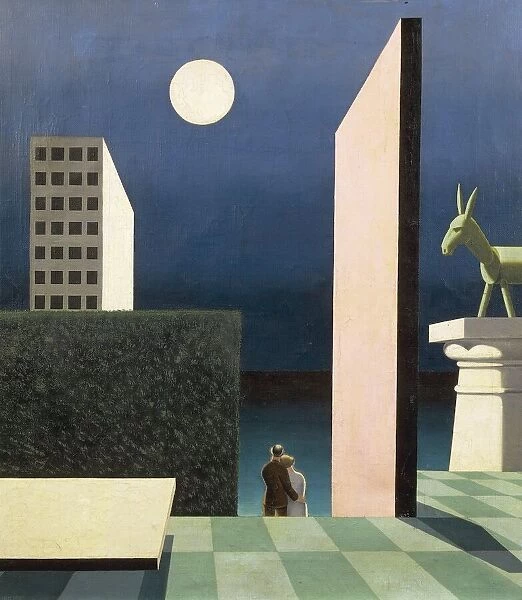
Sándor Bortnyik (1893-1976), Green Donkey, 1924, Oil on canvas, 60 x 55cm © Szépművészeti Múzeum - Museum of Fine Arts Budapest, 2018/19

Sándor Bortnyik (1893-1976), Green Donkey, 1924, Oil on canvas, 60 x 55cm © Szépművészeti Múzeum - Museum of Fine Arts Budapest, 2018/19
Abstraction-Création and
Surrealism
The cosmopolitan attitude
that Paris radiated was still attractive after the First World War. This was encouraged
by the French government, which unlike other European countries, actually consciously
promoted immigration in the 1920s. This liberalness and the possibility of
exchange encouraged the formation of artistic groups. Abstraction-Création is
considered the most important and largest supranational association of the
period. ‘Abstraction’ stands for organically developed forms, and ‘création’
for the composition that is created only with geometric elements. Constructivist
artists, such as László Moholy-Nagy, as well as artists who were oriented
towards Surrealism could join. The only requirement for membership was a
non-figurative artistic approach and a recommendation by one of the members. In
this way Etienne Beöthy recommended his artist colleague Lajos Tihanyi, and
Kupka his fellow Czech countryman
František Foltýn as members.
The large number of artists from the former
Austria- Hungarian Empire is notable, who are represented in this exhibition by
Jindřich Štyrský, Toyen, Zedněk Dvořák,
Wolfgang Paalen, and Friedrich Kiesler. Variations on the figurative While in the work of Oskar Kokoschka and Anton
Kolig the nervous brushstroke remains a characteristic feature of their
expressive style, a more painterly approach was developed in the 1920s. Instead
of an often provocative, extroverted style of painting, the subject matter
becomes more intimate, while the controlled broad brushstroke remains visible,
as in the
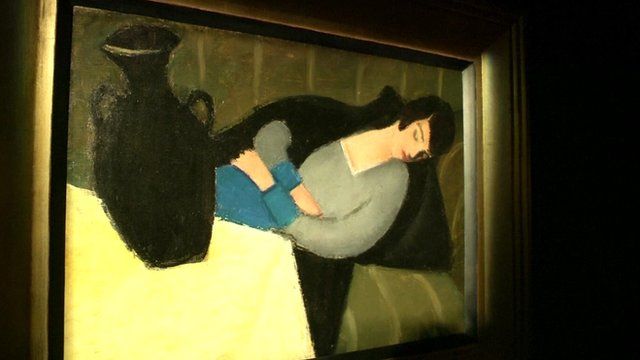
Sleeping Lady with Black Vase by Róbert Berény

or in the Self-Portrait with Comb by Marie-Louise von Motesiczky.


Sleeping Lady with Black Vase by Róbert Berény

Marie-Louise von Motesiczky
Self portrait with comb, 1926
Oil on canvas
83 x 45 cm
© Belvedere, Vienna
or in the Self-Portrait with Comb by Marie-Louise von Motesiczky.

Jenő Barcsay (1900-1988), Red Youths (workers), 1928, Oil on canvas, 75 x 100,7cm, © Szépművészeti Múzeum - Museum of Fine Arts Budapest, 2018/19
Symbolic content
becomes more prevalent in pictures such as Red Boys (Workers) by Jenő Barcsay.
Both of these tendencies are also apparent in sculpture. Fritz Wotruba develops
his Torso in an expressive way, while Mary Duras models the intimacy of
subjects in the sensual clay of her terra-cotta sculptures. On the other hand,
Anton Hanak and Otto Gutfreund embrace a new, comparatively sober Realism in
both of their busts in the exhibition.

Lajos Tihanyi (1985-1938), Composition in Blue and Yellow, 1934, Oil on plywood, 38,5 x 46cm

Lajos Tihanyi (1985-1938)
Composition in Blue and Yellow, 1934
Oil on plywood
38,5 x 46cm
© Szépművészeti Múzeum - Museum of Fine Arts Budapest, 2018/19
Lajos Tihanyi (1985-1938), Composition in Blue and Yellow, 1934, Oil on plywood, 38,5 x 46cm
Scunity and alienating realism
In the economic depression and social malaise
of the late 1920s and early 1930s, the atrocities of the First World War seemed
to be forgotten to such an extent that a combination of militant politics and
an exaggerated nationalism threatened to drag the global world order into a new
conflict. New Objectivity’s themes of social criticism and political or objective
commentary featured in art from Košice to Pilsen and from Vienna to Ljubljana,
Budapest, Belgrade, and Zagreb. The disintegration of society is clearly seen
in the pictures by Herbert Ploberger or Gyula Derkovits, in which luxury and
poverty are the subjects. Alfred Kubin and Franz Sedlacek produced images of
unknown, bizarre threats or the decline of the individual as in the pictures of
Rudolf Wacker. The symbolic fragmentation of the already fragile balance is a
disconcerting foreshadowing of the totalitarian systems that were taking shape.
Based on ideological, ethnic, and religious persecution, these systems question
all morals, and also force into exile artists such as Wilhelm Thöny and ultimately
led to the Second World War.
From
Humanism to Barbarism, via Nationalism
The insidious rise of a dictatorship in
Germany was followed by aggressive power politics, founded on brute violence.
Following the Munich Agreement, not only entire states fell victim to the
aggression of the regime, but also —most crucially—their people. After the
euphoric Roaring Twenties, a time in which artists and intellectuals had
cultivated a dynamic environment for the exchange of ideas, in the 1930s, persecution on political, ethnic, racial, and
religious grounds forced many artists to flee.
Friedl Dicker- Brandeis and Oskar Kokoschka emigrated to Prague, as did the German satirist John Heartfield, whose photomontages were published there starting in 1933. Like Kokoschka, he fled to England shortly before the occupation of Czechoslovakia. The Prague artist Walter Trier and the Hungarian Stefan Lorant fled from Germany to London, where they designed and published satirical newspapers. Dicker-Brandeis, however, was murdered in 1944 in Auschwitz.
Nevertheless, artists opposed the dictatorship and the military occupation. Emil Filla’s painting Variation on a Moravian Folk Song was a rallying call against war and violence. Although Filla was already interned in Dachau in 1939, the painting was still exhibited in Prague. Filla survived his imprisonment in the concentration camp; however, his fellow prisoner Vojtěch Preissig paid with his life for publishing subversive flyers and an underground newspaper.
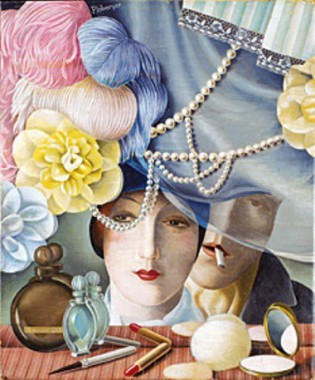
Herbert Ploberger (1902-1977), Window Shopping, 1928, Oil on wood, 40 x 34cm, © Private Collection, Vienna
Friedl Dicker- Brandeis and Oskar Kokoschka emigrated to Prague, as did the German satirist John Heartfield, whose photomontages were published there starting in 1933. Like Kokoschka, he fled to England shortly before the occupation of Czechoslovakia. The Prague artist Walter Trier and the Hungarian Stefan Lorant fled from Germany to London, where they designed and published satirical newspapers. Dicker-Brandeis, however, was murdered in 1944 in Auschwitz.
Nevertheless, artists opposed the dictatorship and the military occupation. Emil Filla’s painting Variation on a Moravian Folk Song was a rallying call against war and violence. Although Filla was already interned in Dachau in 1939, the painting was still exhibited in Prague. Filla survived his imprisonment in the concentration camp; however, his fellow prisoner Vojtěch Preissig paid with his life for publishing subversive flyers and an underground newspaper.

Herbert Ploberger (1902-1977), Window Shopping, 1928, Oil on wood, 40 x 34cm, © Private Collection, Vienna

Gustav Klimt, Johanna Staude
1917-1918
Oil on canvas (unfinished)
70 x 50 cm
© Belvedere, Vienna
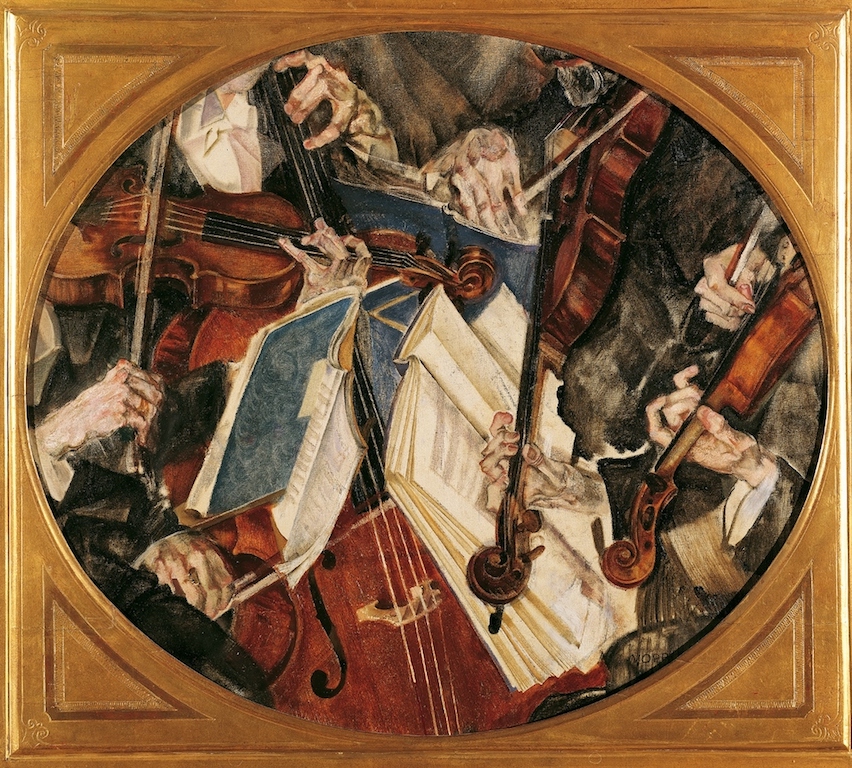
Maximilian Oppenheimer
Klingler-Quartet, 1917
Oil and tempera on canvas
70 x 80 cm (oval)
© Belvedere, Vienna

Oskar Kokoschka Der Prager Hafen, 1936
Oil on canvas
91 x 117 cm
© Belvedere, Vienna
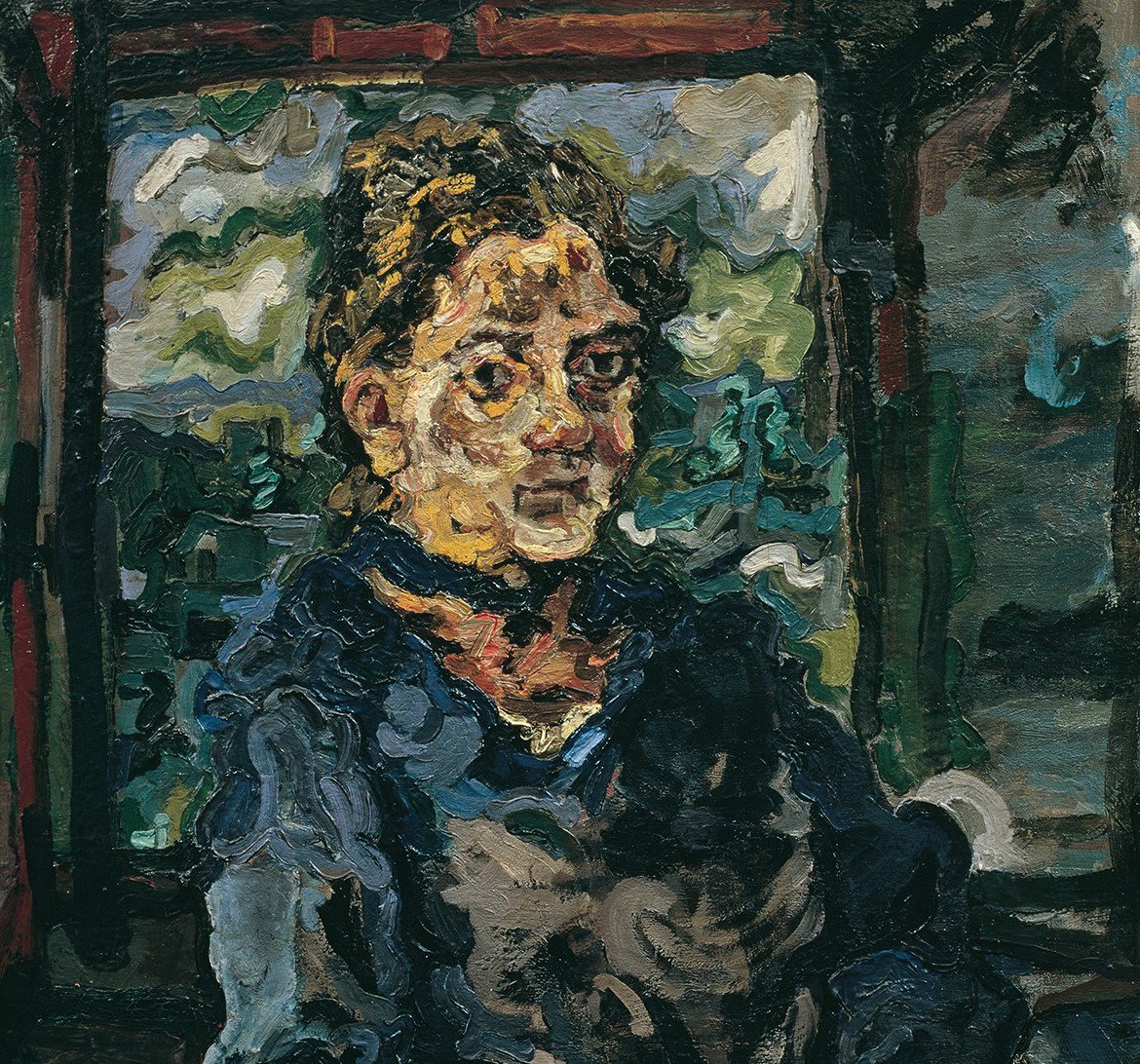
Oskar Kokoschka
Romana Kokoschka, the artist’s mother, 1917
Oil on canvas
112 x 75 cm
© Belvedere, Vienna
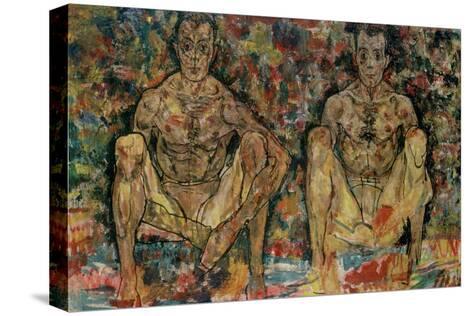
Egon Schiele (1890-1918)
Squatting Men (Double Self-Portrait), 1918
Oil on canvas
100 x 171 cm
© Private Collection, Courtesy Richard Nagy Ltd., London
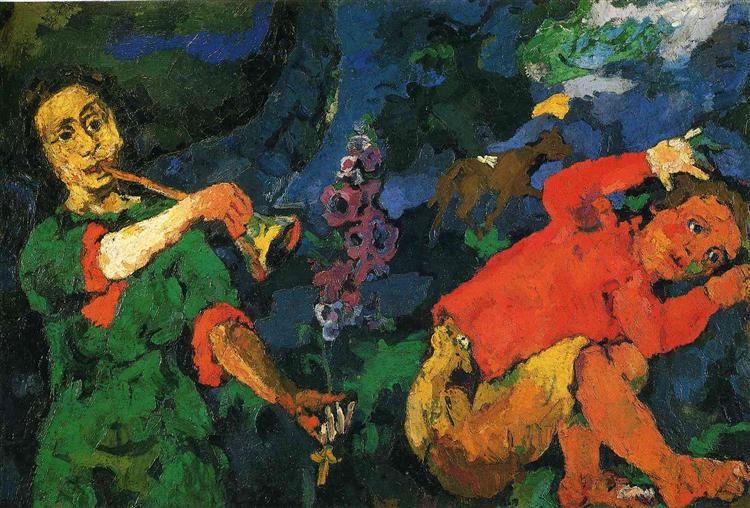
Oskar Kokoschka (1986-1980)
The Power of Music, 1918-19
Oil on canvas
100 x 151,5 cm
© Collection Vanabbemuseum, Eindhoven
František Kupka (1871-1957)
Drinking Steel, 1927
Oil on canvas
46,5 x 55cm
© Private collection, Prague
František Kupka (1871-1957)
Study for Around a Point, 1911-1930
Gouache, watercolor on paper
30,7 x 31,2cm
© Meda Mládek Foundation, Prague
László Moholy-Nagy (1895-1946)
Electric Stage Lightning, 1922-1930
Collage on tracing paper
65,2 x 49,9cm
© Theaterwissenschaftliche Sammlung, Universität zu Köln
Wolfgang Paalen (1905-1959)
Paysage totémique, 1938
Fumage and oil on canvas
130 x 100cm
© Florent Chevrot
József Rippl-Rónai (1861-1927)
Place de l’Observatoire, 1914
Oil on paper
75 x 105cm
© Szépművészeti Múzeum - Museum of Fine Arts Budapest, 2018/19
Lajos Tihanyi (1985-1938)
Portrait of Magdolna Leopold, 1914
Oil on canvas
70,5 x 59,5cm
© St. Stephen’s King Museum – Deák Collection, Székesfehérvár
Toyen (1902-1980)
Abandoned Cave, 1937
Oil on canvas
113 x 77,5cm
© Gallery of Fine Arts in Cheb
Rudolf Wacker (1893-1939)
Still life with Holly, 1933
Oil on plywood
65x50cm
© Private Collection
Erika Giovanna Klien
Composition with String instruments, 1923–1924
Oil on canvas on cartonage
29,5 x 14 cm
© Belvedere, Vienna
John Heartfield
Voice of the Swamp
From Arbeiter Illustrierte-Zeitung (AIZ)
No. 12, Prague 1936
Dead Soldier in Barbed Wire
Robert Angerhofer (1895-1987)
Dead Soldier in Barbed Wire, C. 1920
Oil on canvas
107 x 147cm
© NORDICO Stadtmuseum Linz
Still Life Bols
Emil Filla (1882-1953)
Still Life Bols, 1914
Oil on canvas
30,5 x 46cm
© The Gallery of West Bohemia in Pilsen
Cityscape with Bridges
Béla Kádár (1877-1956)
Cityscape with Bridges, C. 1921
Oil on canvas
69 x 98,5cm
© St. Stephen’s King Museum – Deák Collection, Székesfehérvár
Fortieth Anniversary
Lajos Kassák (1887-1967)
Fortieth Anniversary, 1927
Paper, ink, collage
33 x 49,5cm
© Petőfi Literary Museum – Kassák Museum, Budapest